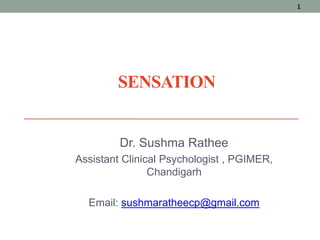
Sensation
- 1. SENSATION Dr. Sushma Rathee Assistant Clinical Psychologist , PGIMER, Chandigarh Email: sushmaratheecp@gmail.com 1
- 2. What is Sensation • Sensation occurs when special receptors in the sense organs— the eyes, ears, nose, skin, and taste buds—are activated, allowing various forms of outside stimuli to become neural signals in the brain. • This process of converting outside stimuli, such as light, into neural activity is called transduction. • Sensory Receptors: “specialized forms of neurons, the cells that make up the nervous system” and receiving neurotransmitters from other cells, these receptor cells are stimulated by different kinds of energy.
- 3. SENSORY THRESHOLDS • Ernst Weber (1795–1878) did studies trying to determine the smallest difference between two weights that could be detected. His research led to the formulation known as Weber’s law of just noticeable differences (jnd, or the difference threshold). • A jnd is the smallest difference between two stimuli that is detectable 50 percent of the time, and Weber’s law simply means that whatever the difference between stimuli might be, it is always a constant.
- 4. • Gustav Fechner expanded on Weber’s work by studying something he called the absolute threshold. • An absolute threshold is the lowest level of stimulation that a person can consciously detect 50 percent of the time the stimulation is present. • Stimuli that are below the level of conscious awareness are called subliminal stimuli. • Stimuli act upon the unconscious mind, influencing behavior in a process called subliminal perception.
- 5. • Supraliminal—“above the threshold”—and detectable by our sensory systems. • Habituation tendency of the brain to stop attending to constant, unchanging information. • Sensory adaptation tendency of sensory receptor cells to become less responsive to a stimulus that is unchanging.
- 6. PERCEPTUALPROPERTIES OF LIGHT • There are three aspects to our perception of light: • Brightness: amplitude of the wave—how high or how low the wave actually is. • Color or hue: is largely determined by the length of the wave. • Saturation: purity of the color people perceive.
- 7. THE STRUCTURE OF THE EYE
- 8. Cont…. • Retina, Rods, and Cones The final stop for light within the eye is the retina, a light sensitive area at the back of the eye containing three layers: ganglion cells, bipolar cells, and the rods and cones, special cells (photoreceptors) that respond to the various light waves. • Dark adaptation occurs as the eye recovers its ability to see when going from a brightly lit state to a dark state. • light adaptation much more quickly than the rods adapt to darkness—it takes a few seconds at most.
- 9. Process of light transfer
- 10. THEORIES OF COLOR VISION: • Two theories about how people see colors were originally proposed in the 1800s. The first is called the trichromatic (“three colors”) theory. First proposed by Thomas Young in 1802 and later modified by Hermann von Helmholtz in 1852, this theory proposed three types of cones: red cones, blue cones, and green cones, one for each of the three primary colors of light. • In the trichromatic theory, different shades of colors correspond to different amounts of light received by each of these three types of cones.
- 11. • Afterimages occur when a visual sensation persists for a brief time even after the original stimulus is removed. The person would also notice rather quickly that the colors of the flag in the afterimage are all wrong—green for red, black for white, and yellow for blue. • COLOR BLINDNESS: color-deficient vision is more accurate, as most people with “color blindness” have two type of cones working and can see many colors. 1. monochrome color blindness: people either have no cones or have cones that are not working at all. 2. dichromatic vision 3. Protanopia (red-green color deficiency) 4. Deuteranopia (another type of red-green color deficiency)
- 12. PERCEPTION OF SOUND • Wavelengths are interpreted by the brain as the frequency or pitch. • Amplitude is interpreted as volume, how soft or loud a sound is. • Saturation or purity in light is called timbre in sound, a richness in the tone of the sound.
- 13. Structure of ear
- 14. • Outer ear: The pinna is the visible, external part of the ear that serves as a kind of concentrator, funneling the sound waves from the outside into the structure of the ear pinna is also the entrance to the auditory canal. • The middle ear: Hammer(malleus), anvil (incus), and stirrup (stapes). • Inner ear: • This fluid surrounds a membrane running through the middle of the cochlea called the basilar membrane. • Basilar Membrane and the Organ of Corti: The basilar membrane is the resting place of the organ of Corti, which contains the receptor cells for the sense of hearing.
- 15. Theory of hearing: 1. Place theory: is based on an idea proposed in 1863 by Hermann von Helmholtz and elaborated on and modified by Georg von Bekesy, beginning with experiments first published in 1928. In this theory, the pitch a person hears depends on where the hair cells that are stimulated are located on the organ of Corti. 2. Frequency theory: developed by Ernest Rutherford in 1886, states that pitch is related to how fast the basilar membrane vibrates. The faster this membrane vibrates, the higher the pitch; the slower it vibrates, the lower the pitch.
- 16. Cont… • Volley principle theory of pitch that states that frequencies from about 400 Hz to 4000 Hz cause the hair cells (auditory neurons) to fire in a volley pattern, or take turns in firing. 1. Conduction hearing impairment: sound vibrations cannot be passed from the eardrum to the cochlea. 2. Nerve hearing impairment: occur in inner ear or in the auditory pathways and cortical areas of the brain.